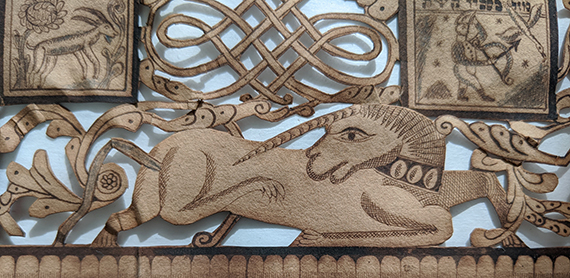Papercutting has a long history in Jewish culture and is still practiced today. It is often used to decorate blessings, prayers, and ritual texts. This particular work contains Hebrew blessings recited after drinking wine and consuming special foods, including baked goods from five grains (wheat, rye, barley, spelt and oats) and specific fruits (dates, pomegranates and figs). The style of the papercut is similar to those made in Eastern Europe in the nineteenth century, leading curators to believe that it may have been produced in Poland in the nineteenth century. The object is fairly large (about 20 by 28 inches) and is the MFA’s only example of a Judaica papercut.
The central text (highlighted in yellow below) is surrounded by intricately cut plants and animals, both real and mythical. The term papercut describes the way these drawn plants and animals have been silhouetted by cutting away the background paper around them. These figures, as well as the text, appear to have been executed with a combination of iron gall ink and graphite.

Iron gall ink is often identified by its distinctive deterioration characteristics. It is made from a mixture of iron and the acidic extracts from an oak gall, a growth that forms on oak trees. The mix of iron and tannic acid produces a rich black ink. Sadly, the ink deteriorates over time, and as it does, the once black lines turn brown. Where the ink was thickly applied, it can even crack and flake off. Iron gall ink deterioration is especially concerning because it weakens paper and can eventually eat through the paper completely. High humidity and temperature also speed up the deterioration, and while the Museum’s climate-controlled storage will slow down the effects, it will not stop the deterioration entirely.

Graphite is a term conservators use to describe the carbon-based material found in the common writing pencil. Because a pencil can contain any number of elements, conservators use the term graphite to be specific about the material that was laid down on the paper.

